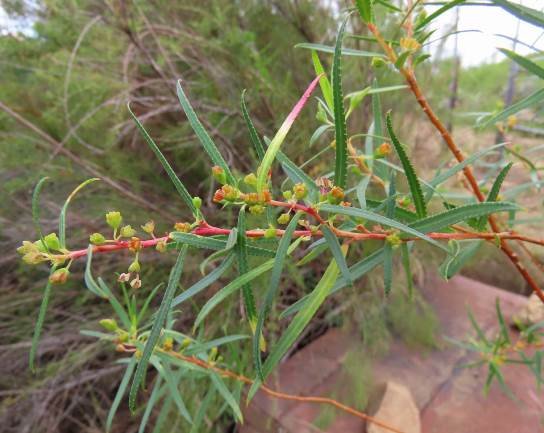Empleurum unicapsulare

Empleurum unicapsulare, commonly known as false buchu, in Afrikaans as bergboegoe (mountain buchu) or waterboegoe (water buchu) and previously scientifically as E. serrulatum, is a single-stemmed, willow-like, evergreen shrub reaching heights around 4 m.
The alternate, simple and stalked leaves are long and narrow, linear with acutely pointed tips. Small, yellow glands along the leaf margins make them appear toothed. The leaves exude a resin or soapy scent, more so when crushed. The leaf dimensions are from 20 mm to 60 mm long and 5 mm wide.
The flowers grow stalked, solitary or in small clusters from upper leaf axils. Male, female and bisexual flowers are grown on the same plant. The thick-lobed, somewhat bell-shaped calyx is yellowish green, about 3 mm in diameter. There are no petals.
Male flowers have four stamens with anthers longer than the filaments. Female flowers have sessile ovaries with one locule and a thick style, shorter than the ovary.
Flowering happens from before midwinter to early summer.
The fruit is narrowly ovate.
The genus name, Empleurum, is derived from the Greek words or word parts em- meaning within and pleuron meaning the ribs or the side, referring to the seeds contained within a membranous inner hull in the capsule. The species name, unicapsulare, is derived from the Latin words or word parts unus meaning one, capsula meaning a small chest and -aris meaning pertaining to or resembling, referring to all the carpels being united in one capsule.
The species distribution is in the Western Cape from Clanwilliam and coastal in the southwest of the Eastern Cape to Uitenhage. The photo was taken near Matjiesrivier and the Kango Caves.
The habitat is fynbos along streambanks and on damp upper slopes. The species is not considered to be threatened in its habitat early in the twenty first century (Vlok and Schutte-Vlok, 2015; Bean and Johns, 2005; Leistner, (Ed.), 2000; Bond and Goldblatt, 1984; Andrew, 2017; iNaturalist; http://redlist.sanbi.org).

